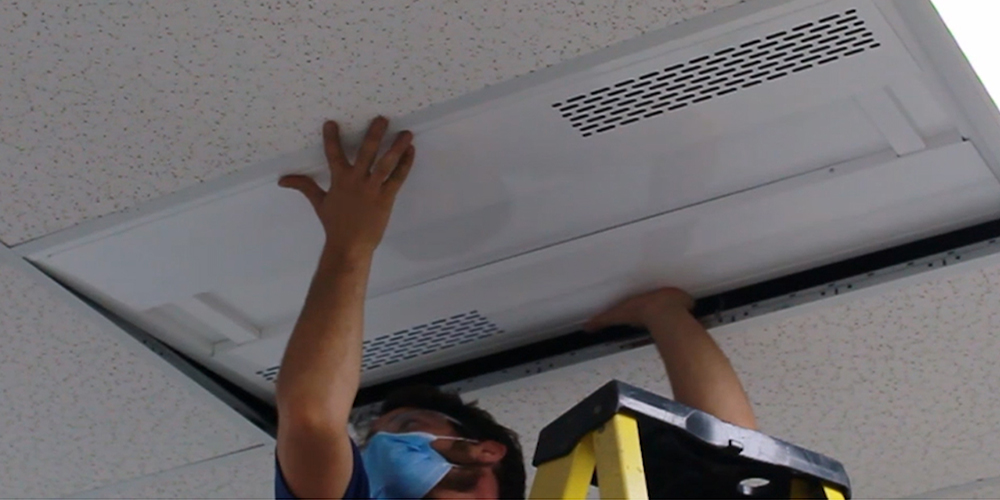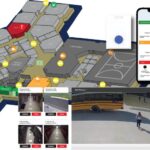With schools taking precautions against COVID-19, an effective tool in their arsenal is a new type of “germicidal” LED fixture. This specialized, enclosed LED fixture draws in air and irradiates it with ultraviolet light (UV), significantly improving indoor safety by providing continuous airborne disinfection of the SARS-CoV-2 (COVID-19) virus as well as other airborne viruses, bacteria, and germs.
While traditional UV fixtures have been used for many years to clean surfaces, they could not be safely used in occupied spaces. The new type is designed to safely and constantly disinfect indoor air in occupied rooms.
Although LED light fixtures normally emit visible light with a 400 nm -700 nm wavelength, lower frequency ultraviolet (UV) light LEDs can effectively kill such pathogens. UVC, a very powerful ultraviolet light wavelength between 100 nm-280 nm, is viricidal, bactericidal, and fungicidal since it passes through the outer wall of the pathogen and causes damage at the molecular level.
The destruction ultimately leads to the inactivation of the pathogen, making the cells unable to reproduce. Also, unlike vaccines, because UV works at the cellular level, it is effective regardless of the pathogen’s ability to adapt or mutate.
UVC is known to disinfect air, water and nonporous surfaces, and has effectively been used for decades to reduce the spread of bacteria such as tuberculosis, influenza and Legionnaire’s disease. According to the Centers for Disease Control and Prevention (CDC), UVC is the only recognized technology for effective germicidal treatment for airborne pathogens.
Today, as the nation continues to battle the pandemic, UVC is a promising tool at the forefront of safely reopening schools because the approach is effective in inactivating the SARS-CoV-2 virus that causes COVID-19.
The CDC has determined that the integration of in-room UVC sources in conjunction with building-wide HVAC systems has great promise, particularly given the growing knowledge of the dangers of airborne spread of the coronavirus. Best of all, these stand-alone UVC fixtures can be used continuously throughout the day, in occupied rooms, even when the HVAC system is off.
“In indoor settings, one of the best ways to combat the COVID SARS-2 family of airborne viruses is to continuously recycle individual room air while safely treating it with UVC radiation,” said Michael Fischer, President of Energy Harness, a Florida-based designer and manufacturer of LED lighting for a variety of commercial settings. “Unlike traditional wide spectrum fluorescent or mercury vapor UV tubes, LEDs can produce UVC by controlling the specific wavelengths of light emitted. In addition, they don’t contain extremely toxic substances like arsenic or mercury that are inherent in the traditional UV tubes.”
When the COVID pandemic began, Fischer said his team quickly realized the potential effectiveness of UVC technology to deactivate the SARS-CoV-2 virus and used the technology to design a fixture to treat the airborne organisms.
However, to do this required technology that could safely deliver the proper UVC dosage in a specific combination of three main factors – dosage, distance and wavelength.
“Ultimately, germicidal efficacy of ultraviolet light is based on dosage, distance and wavelength,” explains Fischer. “Dosage is a function of UVC power multiplied by exposure time. Distance is the proximity of the pathogen to the UVC source. And wavelength is the nanometer range of the ultraviolet light.”
According to Fischer, to eradicate pathogens effectively, the UVC wavelength should be in the germicidal effective range, with a peak of approximately 268 nm. The intensity must be high enough to irradiate the space, and the duration must be long enough to affect the organism. He spells out the equation as (Wavelength Intensity * Duration) = Dosage Delivered.
A growing number of school systems are adopting UVC technology to mitigate the potential spread of COVID-19 and other viruses.
“We were very impressed with the UVC technology… and recently installed [units] in our elementary classrooms,” said Darrell Thompson, OPMP, Director of Facilities at the Center Grove Community School Corporation, a public school system that serves the residents of White River Township in Johnson County, Indiana.
According to Center Grove’s website, it educates approximately 8,500 K-12 students and has a staff of more than 1,100.
“We were so impressed that we expanded our scope to include the cafeterias and nurses’ stations. We believe this will have a huge positive impact on the health and well-being of our students and staff,” he added.
While schools are slowly opening up under pandemic restrictions, the incorporation of fixtures that can continuously kill airborne pathogens – including the COVID-19 virus – while occupants are in the room will be vital to aid safe reopening.
Del Williams is a technical writer located in Torrance, California.













